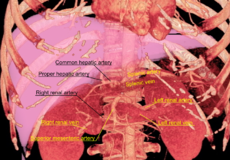- Distal splenorenal shunt procedure
-
Distal splenorenal shunt procedure Intervention 
3D rendered CT of abdominal aortic branches and kidneys, to show relative position of veins. Splenic vein and left renal vein labeled at center right.ICD-9-CM 39.1 MeSH D013164 In medicine, a distal splenorenal shunt procedure (DSRS), also splenorenal shunt procedure and Warren shunt,[1] is a surgical procedure in which the distal splenic vein (a part of the portal venous system) is attached to the left renal vein (a part of the systemic venous system). It is used to treat portal hypertension and its main complication (esophageal varices).[2]
Contents
Splenopancreatic and gastric disconnection (SPGD)
DSRS is typically done with splenopancreatic and gastric disconnection (ligation of the gastric veins and pancreatic veins (that drain into the portal vein) and complete detachment of the splenic vein from the portal venous system), as it improves the outcome.[3]
Comparison to TIPS
Survival with a transjugular intrahepatic portosystemic shunt (TIPS) versus a DSRS is thought to be approximately similar,[4][5] but still an area of intensive research.[6][7]
Both TIPS and DSRS lead to decreased rates of variceal bleeding at the expense of hepatic encephalopathy; however, TIPS appears to have more shunt dysfunction and lead to more encephalopathy and bleeds.[5] DSRS appears to be more cost effective than TIPS.[8]
References
- ^ Warren WD, Henderson JM, Millikan WJ et al. (1986). "Distal splenorenal shunt versus endoscopic sclerotherapy for long-term management of variceal bleeding. Preliminary report of a prospective, randomized trial". Ann. Surg. 203 (5): 454–62. doi:10.1097/00000658-198605000-00002. PMC 1251141. PMID 3486641. http://www.pubmedcentral.nih.gov/articlerender.fcgi?tool=pmcentrez&artid=1251141.
- ^ Boyer TD, Kokenes DD, Hertzler G, Kutner MH, Henderson JM (1994). "Effect of distal splenorenal shunt on survival of patients with primary biliary cirrhosis". Hepatology 20 (6): 1482–6. doi:10.1002/hep.1840200617. PMID 7982648.
- ^ Hirano S, Kondo S, Ambo Y et al. (2005). "Appraisal of DSRS with SPGD for esophagogastric varices: a retrospective comparative study according to the underlying liver diseases". Hepatogastroenterology 52 (61): 152–5. PMID 15783017.
- ^ Rockey DC. Update on the Role of TIPS in the Management of Portal Hypertension. Medscape.com. URL: http://www.medscape.com/viewarticle/492983. Accessed on March 18, 2006.
- ^ a b Khan S, Tudur Smith C, Williamson P, Sutton R (2006). Khan, Saboor A. ed. "Portosystemic shunts versus endoscopic therapy for variceal rebleeding in patients with cirrhosis". Cochrane database of systematic reviews (Online) (4): CD000553. doi:10.1002/14651858.CD000553.pub2. PMID 17054131.
- ^ "Multicenter, Randomized Trial of DSRS vs. TIPS". University of Wisconsin- Madison, General Surgery. http://www.surgery.wisc.edu/general/research/grants_rikkers_nih.shtml.
- ^ Henderson JM, Boyer TD, Kutner MH et al. (2006). "Distal splenorenal shunt versus transjugular intrahepatic portal systematic shunt for variceal bleeding: a randomized trial". Gastroenterology 130 (6): 1643–51. doi:10.1053/j.gastro.2006.02.008. PMID 16697728. http://linkinghub.elsevier.com/retrieve/pii/S0016-5085(06)00270-8.
- ^ Zacks SL, Sandler RS, Biddle AK, Mauro MA, Brown RS (1999). "Decision-analysis of transjugular intrahepatic portosystemic shunt versus distal splenorenal shunt for portal hypertension". Hepatology 29 (5): 1399–405. doi:10.1002/hep.510290512. PMID 10216122.
External links
- Distal Splenorenal Shunt Procedure (Cleveland Clinic) - has some schematics that show what is done in the procedure.
- Portal Hypertension (Mohawk Valley Vascular Center) - has some schematics that show what is done in the procedure.
Health science – Medicine · Surgery · Vascular surgery and other vascular procedures (ICD-9-CM V3 38-39, ICD-10-PCS 03-6) Incision, excision,
and occlusion
of vesselsPeripheral arterial occlusive disease: Balloon embolectomy · Thrombectomy
Carotid stenosis: Endarterectomy (Carotid endarterectomy)
Varicose veins: Ambulatory phlebectomy · Laser ablation · Sclerotherapy · Vein stripping
Temporal artery biopsy
Arteriotomy · PhlebotomyOther operations
on vesselsPeripheral arterial occlusive disease: Peripheral arterial bypass surgery
Portal hypertension: Transjugular intrahepatic portosystemic shunt (TIPS) · Distal splenorenal shunt procedure
Vascular grafting (Human umbilical vein graft)
Blalock–Taussig shuntRepairAortic aneurysm / dissection: Open AAA repair · Endoluminal AAA repair (EVAR)
Peripheral arterial occlusive disease: Angioplasty with/out Stenting
AtherectomyAuxiliary to
heart surgeryOtherMedical imaging Angiography (Digital subtraction angiography, Cerebral angiography, Aortography, Fluorescein angiography, Radionuclide angiography, Magnetic resonance angiography)
Venography (Portography) · Impedance phlebography
Intravascular ultrasound · Carotid ultrasonographyOther diagnostic 
This medical treatment-related article is a stub. You can help Wikipedia by expanding it.
